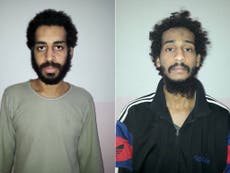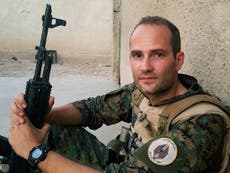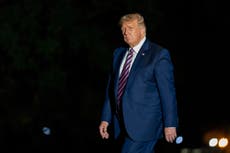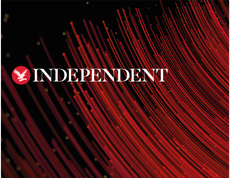Canada arrest of alleged hoaxer casts doubt over NYT podcast ‘Caliphate’ and its star
Newspaper forced to scrutinise its reportage after source charged with lying

Your support helps us to tell the story
From reproductive rights to climate change to Big Tech, The Independent is on the ground when the story is developing. Whether it's investigating the financials of Elon Musk's pro-Trump PAC or producing our latest documentary, 'The A Word', which shines a light on the American women fighting for reproductive rights, we know how important it is to parse out the facts from the messaging.
At such a critical moment in US history, we need reporters on the ground. Your donation allows us to keep sending journalists to speak to both sides of the story.
The Independent is trusted by Americans across the entire political spectrum. And unlike many other quality news outlets, we choose not to lock Americans out of our reporting and analysis with paywalls. We believe quality journalism should be available to everyone, paid for by those who can afford it.
Your support makes all the difference.Derek Henry Flood was not looking for work in March 2018, when he sent a direct message to a New York Times reporter he admired, Rukmini Callimachi, to congratulate her on the announcement of her big new podcast about the terror group known as the Islamic State.
By that time, major American news outlets had mostly stopped hiring freelancers like Flood in Syria, scared off by a wave of kidnappings and murders.
But when Flood mentioned that he was in the northern city of Manbij, Callimachi wrote back and quickly hired him for a curious assignment.
She sent him to the local market to ask about a Canadian Islamic State fighter called Abu Huzayfah.
The assignment, Flood recalled thinking, was both hopeless and quite strange in its specificity, since the extremist group had been forced out of Manbij two years earlier. But he was getting $250 (£191.8) a day, so he gamely roamed the bazaar, reporting on all he saw and heard. Callimachi was singularly focused.
“She only wanted things that very narrowly supported this kid in Canada’s wild stories,” he told me in a phone interview.
Flood didn’t know it at the time, but he was part of a frantic effort at The New York Times to salvage the high-profile project the paper had just announced.
Days earlier, producers had sent draft scripts of the series, called Caliphate, to the international editor, Michael Slackman, for his input. But Slackman instead called the podcast team into the office of another top Times editor, Matt Purdy, a deputy managing editor who often signs off on investigative projects.
The editors warned that the whole story seemed to depend on the credibility of a single character, the Canadian, whose vivid stories of executing men while warm blood “sprayed everywhere” were as lurid as they were uncorroborated. (This scene and others were described to me in interviews with more than two dozen people at The Times, many of whom spoke on condition of anonymity because of the sensitive internal politics.)
The Times was looking for one thing: evidence that the Canadian’s story was true. In Manbij, Flood wandered the marketplace until a gold merchant warned him that his questions were attracting dangerous attention, prompting him to quickly board a bus out of town.
Across the Middle East, other Times reporters were also asked to find confirmation of the source’s ties to ISIS, and communicated in WhatsApp channels with names like “Brilliant Seekers” and “New emir search.” But instead of finding Huzayfah’s emir, they found that Isis defectors had never heard of him.
In New York, Malachy Browne, a senior producer of visual investigations at The Times, managed to confirm that an image from Huzayfah’s phone had been taken in Syria – but not that he had traveled there.
Still more Times reporters in Washington tried to find confirmation. One of them, Eric Schmitt, pulled a thread that appeared to save the project.
"What two different officials in the US government at different agencies have told me is that this individual, this Canadian, was a member of Isis,” he says on the podcast. “They believe that he joined ISIS in Syria.” But Schmitt and his colleagues, Times journalists told me, never determined why those government officials viewed him as part of Isis, or if indeed they had any evidence of his Isis connections other than the professed terrorist’s own social media pronouncements.
A month later, The Times audio team moved forward. The first episode of Caliphate appeared on April 19, 2018, marking a major step toward The Times’ realisation of its multimedia ambitions. It was promoted with a glossy marketing campaign that featured an arresting image, with the rubble of Mosul on one side and Callimachi’s face on the other.
The series was 10 parts in all, including a new, sixth episode released on 24 May of that year detailing doubts about Huzayfah’s story and The Times’ efforts to confirm it. The presentation carried an obvious, if implicit, assumption: the central character of the narrative wasn’t making the whole story up.
That assumption appeared to blow up a couple of weeks ago, on 25 September, when Canadian police announced that they had arrested the man who called himself Abu Huzayfah, whose real name is Shehroze Chaudhry, under the country’s hoax law.
The details of the Canadian investigation aren’t yet public. But the recriminations were swift among those who worked with Callimachi at The Times in the Middle East.
“Maybe the solution is to change the podcast name to #hoax?” tweeted Margaret Coker, who left as The Times’ Iraq bureau chief in 2018 after a bitter dispute with Callimachi and now runs an investigative journalism startup in Georgia.
The Times has assigned a top editor, Dean Murphy, who heads the investigations reporting group, to review the reporting and editing process behind Caliphate and some of Callimachi’s other stories, and has also assigned an investigative correspondent with deep experience in national security reporting, Mark Mazzetti, to determine whether Chaudhry ever set foot in Syria and other questions opened by the arrest in Canada.
The crisis now surrounding the podcast is as much about The Times as it is about Callimachi. She is, in many ways, the new model of a New York Times reporter. She combines the old-school bravado of the parachuting, big foot reporter of the past with a modern savvy for surfing Twitter’s narrative waves and spotting the sorts of stories that will explode on the internet. She embraced audio as it became a key new business for the paper, and linked her identity and her own story of fleeing Romania as a child to her work. And she told the story of Isis through the eyes of its members.
Callimachi’s approach and her stories won her the support of some of the most powerful figures at The Times: early on, from Joe Kahn, who was foreign editor when Callimachi arrived and is now managing editor and viewed internally as the likely successor to the executive editor, Dean Baquet; and later, an assistant managing editor, Sam Dolnick, who oversees the paper’s successful audio team and is a member of the family that owns The Times.
She was seen as a star – a standing that helped her survive a series of questions raised over the last six years by colleagues in the Middle East, including the bureau chiefs in Beirut, Anne Barnard, and Iraq, Coker, as well as the Syrian journalist who interpreted for her on a particularly contentious story about US hostages in 2014, Karam Shoumali. And it helped her weather criticism of specific stories from Arabic-speaking academics and other journalists.
Many of those arguments have been reexamined in recent days in The Daily Beast, The Washington Post and The New Republic. CJ Chivers, an experienced war correspondent, clashed particularly bitterly with Kahn over Callimachi’s work, objecting to her approach to reporting on Western hostages taken by Islamic militants. Chivers warned editors of what he saw as her sensationalism and inaccuracy, and told Slackman, three Times people said, that turning a blind eye to problems with her work would “burn this place down”.
Callimachi’s approach to storytelling aligned with a more profound shift underway at The Times. The paper is in the midst of an evolution from the stodgy paper of record into a juicy collection of great narratives, on the web and streaming services.
And Callimachi’s success has been due, in part, to her ability to turn distant conflicts in Africa and the Middle East into irresistibly accessible stories. She was hired in 2014 from The Associated Press after she obtained internal al-Qaeda documents in Mali and shaped them into a darkly funny account of a penny-pinching terrorist bureaucracy.
But the terror beat lends itself particularly well to the seductions of narrative journalism. Reporters looking for a terrifying yarn will find terrorist sources eager to help terrify. And journalists often find themselves relying on murderous and untrustworthy sources in situations where the facts are ambiguous. If you get something wrong, you probably won’t get a call from the Isis press office seeking a correction.
“If you scrutinised anyone’s record on reporting at Syria, everyone made grave, grave errors,” said Theo Padnos, a freelance journalist held hostage for two years and now working on a book, who said The Times’ coverage of his cellmate’s escape alerted his captors to his complicity in it. “Rukmini is on the hot seat at the moment, but the sins were so general.”
Terrorism coverage can also play easily into popular American hostility toward Muslims. Callimachi at times depicted terrorist supersoldiers, rather than the alienated and dangerous young men common in many cultures. That hype shows up in details like The Times’ description of the Charlie Hebdo shooters acting with “military precision”.
By contrast, The Washington Post’s story suggested that the killers were, in fact, untrained, and that video shows that they “cross each other’s paths as they advance up the street – a type of movement that professional military personnel are trained to avoid”. On Twitter, where she has nearly 400,000 followers, Callimachi speculated on possible Isis involvement in high-profile attacks, including the 2017 Las Vegas shooting, which has not been attributed to the group. At one moment in the Caliphate podcast, Callimachi hears the doorbell ring at home and panics that Isis has come for her, an effective dramatic flourish but not something American suburbanites had any reason to fear.
Callimachi told me in an email that she had received warnings from the FBI of credible threats against her, and that in any event, that moment in the podcast “is not about Isis or its presence in the suburbs, but about how deeply they had seeped into my mind”.
Her work had impact at the highest levels. A former Trump aide, Sebastian Gorka, a leading voice for the White House’s early anti-Muslim immigration policies, quoted Callimachi’s work to reporters to predict a wave of Isis attacks in the US. Two Canadian national security experts wrote in Slate that the podcast “profoundly influenced the policy debate” and pushed Canada to leave the wives and children of Isis fighters in Kurdish refugee camps.
The haziness of the terrorism beat also raises the question of why The Times chose to pull this particular tale out of the chaotic canvas of Syria’s collapse.
“The narrative her work perpetuates sensationalises violence committed by Arabs or Muslims by focusing almost exclusively on – even pathologising – their culture and religion,” said Alia Malek, the director of international reporting at the Newmark Graduate School of Journalism at City University of New York and the author of a book about Syria. That narrative, she said, often ignores individuals’ motives and a geopolitical context that includes decades of American policy.
“That might make for much more uncomfortable listening, but definitely more worthwhile," she added.
Callimachi told me she has been focused on “just how ordinary Isis members are” and that her work “has always made a hard distinction between the faith practiced by over a billion people and the ideology of extremism”.
Baquet declined to comment on the specifics of Callimachi’s reporting or the internal complaints about it, but he defended the sweep of her work on Isis.
“I don’t think there’s any question that Isis was a major important player in terrorism,” he said, “and if you look at all of The Times’ reporting over many years, I think it’s a mix of reporting that helps you understand what gives rise to this.” (Baquet and Kahn, I should note here, are my boss’ boss’ boss and my boss’ boss, respectively, and my writing about The Times while on its payroll brings with it all sorts of potential conflicts of interest and is generally a bit of a nightmare.)
While some of her colleagues in the Middle East and Washington found Callimachi’s approach to Isis coverage overzealous, others admired her relentless work ethic.
“Is she aggressive? Yes, and so are the best reporters,” said Adam Goldman, who covers the FBI for The Times and has argued in favour of the kind of reporting on hostages that alienated Callimachi from other colleagues like Chivers. “None of us are infallible.”
What is clear is that The Times should have been alert to the possibility that, in its signature audio documentary, it was listening too hard for the story it wanted to hear – “rooting for the story”, as The Post’s Eric Wemple put it on Friday. And while Baquet emphasised in an interview last week that the internal review would examine whether The Times was not keeping to its standards in the audio department, the troubling patterns surrounding Callimachi’s reporting were clear before Caliphate.
Take one story from 2014. The article, which led the front page on 28 December describes a Syrian captive of Isis, who was going by the name of Louai Abo Aljoud, who “made eye contact with the American hostages being held by the Islamic State militant group” at a prison at an abandoned potato chip factory in Aleppo and tried to report them to an indifferent US government.
“I thought that I had truly important information that could be used to save these people,” Callimachi quoted him as saying. “But I was deeply disappointed.”
The story is told with verve and confidence. As a reader, you feel as if you were there.
But elements of the story were shaky: By the time, in Abo Aljoud’s telling, that he was trying to alert the US government that he had seen the hostages, the Islamic State no longer controlled the area the prison was said to be in. Abo Aljoud had told The Wall Street Journal the same story, and The Journal passed on it because journalists there did not believe him, two of those involved told me. And the Syrian journalist who assisted Callimachi on the story and interpreted the interview, Shoumali, told me that he “warned” her not to trust Abo Aljoud “before, during and after” the interview, in vain. (Callimachi said she didn’t recall the warnings before publication, and noted that they don’t appear in correspondence between her and Shoumali before publication.)
Shoumali said he came away from the experience alarmed by her methods.
“I worked for so many reporters, and we were seeking facts. With Rukmini, it felt like the story was pre-reported in her head and she was looking for someone to tell her what she already believed, what she thought would be a great story,” said Shoumali, who was a reporter for The Times from 2012 to 2019 and had a freelance byline this August. He spoke to me by phone from Berlin, where he is now working on a project for a think tank.
Eight days after the story was published, Shoumali wrote to Callimachi and other Times reporters, in an email exchange I obtained, saying that “Syrian contacts are raising more and more questions about the credibility of one of our sources” and that Abo Aljoud had changed details of the story in a conversation the two men had after the story was published.
Callimachi emailed back that details of the prison scene were “confirmed independently by European hostages held in the same location or else by the State Department” – a response that seems puzzling, given that the story presented Abo Aljoud’s observations as his eyewitness account.
The Times was worried enough about that 2014 story to send a different reporter, Tim Arango, back to southern Turkey soon after it was published to re-interview Abo Aljoud, who gamely repeated his story to him and Shoumali. I tried again in early October.
Like Callimachi, I don’t speak Arabic and hired another Syrian journalist to ask Abo Aljoud my questions. In that interview, he told a version of the story that appeared in The Times, but with elements that muddied the clean narrative. He said he had only seen one hostage, not the three The Times suggests. And he said he didn’t realise until after his release that he’d seen any of them – contrary to the impression left by The Times article.
Callimachi said in an email that she wished the story had been clearer about the “limitations” of reporting on terrorists. “Looking back, I wish I had added more attribution so that readers could know the steps I took to corroborate details of his account,” she said.
Kahn, the international editor at the time, continues to stand by the story.
“Questions that were raised about a source in a story Rukmini wrote about American hostages in Syria were thoroughly examined at the time by reporters and editors on the International desk and by The Times’ public editor, and the results of those reviews were published,” he said in an email. “I am not aware of new information that casts doubt on the way it was handled.”
Those questions aside, the article arguably had an impact in Washington, pushing the US government to reconsider its ban on paying ransom. But the piece itself now rests under an uncomfortable cloud of doubt. It remains on The Times website, with no acknowledgment of the questions surrounding the opening anecdote. The only correction says that the story, when first published, did not make clear that Abo Aljoud had used a pseudonym.
Last month, that same cloud of doubt descended on Caliphate. And Callimachi now faces intense criticism from inside The Times and out – for her style of reporting, for the cinematic narratives in her writing and for The Times’ place in larger arguments about portrayals of terrorism.
But while some of the coverage has portrayed her as a kind of rogue actor at The Times, my reporting suggests that she was delivering what the senior-most leaders of the news organisation asked for, with their support.
The New York Times















Join our commenting forum
Join thought-provoking conversations, follow other Independent readers and see their replies
Comments